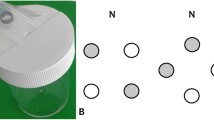Abstract
Thick-tailed galagos,Galago crassicaudatus argentatus, which had been habituated to the scent marks of a conspecific through repeated presentations, increased their sniffing when presented with scent marks from a second conspecific of the same sex. Thus, they discriminated between the scents of individual conspecifics. This result was obtained using naturally scent-marked perches and perches carrying only chest gland scent—the latter even two weeks after the marking. When urine, the prevalent scent signal among most other galago species, was tested, it elicited little interest and discriminations were not clearly made. It is suggested that the use of more specialized scents is related to the social characteristics ofGalago crassicaudatus.
Similar content being viewed by others
References
Adams, M.G. 1980. Odour-producing organs of mammals.Symp. Zool. Soc. London 45:57–86.
Albone, E.S., Gosden, P.E., Ware, G.C., Macdonald, D.W., andHough, N.G. 1978. Bacterial action and chemical signalling in the red foxVulpes vulpes and other mammals.Am. Chem. Soc. Symp. Ser. 67:92–99.
Andrew, R.J. 1964. The displays of the primates, pp. 227–309,in J. Buettner-Janusch (ed.). Evolutionary and Genetic Biology of Primates, Vol. 2. Academic Press, New York.
Bearder, S.K. 1975. Aspects of the ecology and behaviour of the thick-tailed bushbabyGalago crassicaudatus. Unpublished PhD thesis, University of Witwatersrand, Johannesburg.
Bearder, S.K., andDoyle, G.A. 1974. Ecology of bushbabies,Galago senegalensis andGalago crassicaudatus, with some notes on their behaviour in the field, pp. 109–130,in R.D. Martin, G.A. Doyle, and A.C. Walker (eds.). Prosimian Biology. Duckworth, London.
Beauchamp, G.K. 1976. Diet influences attractiveness of urine in guinea pigs.Nature 263:587–588.
Charles-Dominique, P. 1972. Ecologie et vie sociale deGalago demidovii (Fischer 1808; Prosimii).Z. Tierpsychol. Suppl 9:7–41.
Charles-Dominique, P. 1977a. Urine marking and territoriality inGalago alleni (Waterhouse, 1837-Lorisoidea, Primates)-a field study by radio-telemetry.Z. Tierpsychol. 43:113–138.
Charles-Dominique, P. 1977b. The Behaviour and Ecology of Nocturnal Prosimians. Duckworth, London.
Clark, A.B. 1975. Olfactory communication by scent-marking in a prosimian primate,Galago crassicaudatus. Unpublished PhD thesis, University of Chicago.
Clark, A.B. 1978. Olfactory communication,Galago crassicaudatus and the social life of prosimians, pp. 109–117,in D.J. Chivers and K. Joysey (eds.). Recent Advances in Primatology, Volume 3, Evolution. Academic Press, New York.
Clark, A.B. 1980. Spatial aspects of sociality inGalago crassicadautus. Paper presented at XIIIth Intern. Congr. Primatol. Florence, Italy.Antropol. Contemp. 3:181.
Clark, A.B. 1982. Scent marks as social signals inGalago crassicaudatus. I. Sex and reproductive status as factors in signals and responses.J. Chem. Ecol. 8:1133–1151.
Crewe, R.M., Burger, B.V., Roux, M., andKatsir, Z. 1979. Chemical constituents of the chest gland secretion of the thick-tailed galago (Galago crassicaudatus).J. Chem. Ecol. 5:861–868.
Dixson, A. F., andVan Horn, R.N. 1977. Comparative studies of morphology and reproduction in two subspecies of the Greater bushbaby,Galago crassicaudatus crasssicaudatus andG. c. argentatus.J. Zool. 183:517–526.
Eaglen, R.H., andSimons, E.L. 1980. Notes on the breeding biology of thick-tailed and silvery galagos in captivity.J. Mammal. 61(3):534–537.
Epple, G. 1973. The role of pheromones in the social communication of marmoset monkeys (Callitrichidae).J. Reprod. Fert. Suppl. 19:447–454.
Epple, G. 1978. Studies on the nature of chemical signals in scent marks and urine ofSaguinus fuscicollis (Callitrichidae, Primates).J. Chem. Ecol. 4:383–394.
Gorman, M.L. 1976. A mechanism for individual recognition by odor inHerpestes auroptmctatus (Carnivora: Viverridae).Anim. Behav. 24:141–145.
Gorman, M. L. 1979. Sweaty mongooses and other smelly carnivores.Symp. Zool. Soc. London 45:87–105.
Harcourt, C.S. 1980. Behavioral adaptation in South African galagos. Unpubl. MSc thesis, University of Witwatersrand, Johannesburg.
Harcourt, C.S. 1981. An examination of the function of urine washing inGalago senegalensis.Z. Tierpsychol. 55:119–128.
Harrington, J.E. 1974. Olfactory communication inLemur fulvus, pp. 331–346,in R.D. Martin, G.A. Doyle, and A. Walker (eds.). Prosimian Biology. Duckworth, London.
Harrington, J.E. 1976. Discrimination between individuals by scent.Anim. Behav. 24:207–212.
Katsir, Z., andCrewe, R.M. 1980. Chemical communication inGalago crassicaudatus: Investigation of the chest gland secretion.S. Afr. J. Zool. 15(4):249–254.
Martin, R.D., andBearder, S.K. 1980. Radio bushbaby.Nat. Hist. 88(8):76–81.
Mertl, A. 1975. Discrimination of individuals by scent in a primate.Behav. Biol. 14:505–509.
Muller-Schwarze, D. 1971. Pheromones in black-tailed deer.Anim. Behav. 19:141–152.
Olson, T. 1979. Studies on aspects of the morphology and systematics of the genusOtolemur Coquerel, 1859 (Primates: Galagidae). Unpubl. PhD thesis, University of London. University microfilms ref. no. 79-70,038.
Patzor, L.M. 1976. Species identification by chromosome analysis.Primate News 14:3–7.
Patzor, L.M., andVan Horn, R.N. 1976. Twinning in prosimians.J. Hum. Evol. 5:333–337.
Rasa, O.A.E. 1973. Marking behaviour and its social significance in the African dwarf mongoose,Helogale undulata rufula.Z. Tierpsychol. 32:293–318.
Russell, M. J. 1976. Human olfactory communication.Nature 260:520–522.
Schilling, A. 1979. Olfactory communication in prosimians, pp. 461–542,in G.A. Doyle and R.D. Martin, (eds.). The Study of Prosimian Behavior. Academic Press, New York.
Schilling, A. 1980. The possible role of urine in territoriality of some nocturnal prosimians.Symp. Zool. Soc. London 45:165–193.
Schultze-Westrum, T. 1965. Innerartliche Verstandigung durch Dufte beim GleitbeutlerPetaurus breviceps papuanus Thomas (Marsupialia, Phalangeridae).Z. Vergl. Physiol. 50:151–220.
Schultze-Westrum, T.G. 1969. Social communication by chemical signals in flying phalangers (Petaurus breviceps papuanus), pp. 268–277,in C. Pfaffman (ed.). Olfaction and Taste III. Rockefeller University Press, New York.
Smith, W.J. 1977. The Behavior of Communicating. Harvard University Press, Cambridge, Massachusetts.
Vincent, F. 1969. Contribution a l'etude des prosimiens africains. Le Galago de Demidoff. These de Doctorat d'Etat, Paris. (CNRS No. A03575).
Wheeler, J.W., Blum, M.S., andClark, A. 1977. β-(p-hydroxyphenyl) ethanol in the chest gland secretion of a galago (Galago crassicaudatus).Experientia 33:988.
Author information
Authors and Affiliations
Rights and permissions
About this article
Cite this article
Clark, A.B. Scent marks as social signals inGalago crassicaudatus II. Discrimination between individuals by scent. J Chem Ecol 8, 1153–1165 (1982). https://doi.org/10.1007/BF00986985
Received:
Revised:
Issue Date:
DOI: https://doi.org/10.1007/BF00986985




